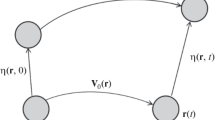Abstract
A method for calculating the propagation of unsteady disturbances along the duct of a turbofan engine, taking into account nonlinear effects, is presented. It is based on finding a solution in the form of a finite set of circumferential modes and performing calculations for the complex amplitudes of these modes using the harmonic balance method. The use of the method can speed up the calculation of the propagation of disturbances through the air intake and the nozzle of a turbofan engine in the case when the influence of nonlinear effects cannot be neglected. The method under consideration is implemented in the Central Institute of Aviation Motors (CIAM) 3 Dimensional Acoustics Solver (3DAS) software package. It is tested on the problem of calculating the nonlinear interaction of acoustic modes in a 2D cylindrical channel. The calculation results using this method are in close agreement with the results of the calculation performed in the time domain.




Similar content being viewed by others
REFERENCES
E. Manoha and D.-C. Mincu, “Numerical simulation of the fan noise radiated through a semi-buried air inlet,” in 15th AIAA/CEAS Aeroacoustics Conference (30th AIAA Aeroacoustics Conference) (Miami, FL, May 11–13, 2009), AIAA Paper AIAA-2009-3293.
I. D. Roy, W. Eversman, and H. D. Meyer, “Improved finite element modeling of the turbofan engine inlet radiation problem,” NASA Contractor Report NASA-CR-204341 (1993).
X. Zhang, X. X. Chen, C. L. Morfey, and P. A. Nelson, “Computation of spinning modal radiation from an unflanged duct,” AIAA J. 42, 1795–1801 (2004).
M. A. Nyukhtikov, A. A. Rossikhin, V. V. Sgadlev, and I. A. Brailko, “Numerical method for turbomachinery tonal noise generation and radiation simulation using CAA approach,” in Proc. ASME Turbo Expo 2008: Power for Land, Sea, and Air (Berlin, Germany, June 9–13, 2008), Vol. 6: Turbomachinery, Parts A, B, and C, Paper No. GT2008-51182, pp. 887–894.
I. A. Brailko, V. I. Mileshin, M. A. Nyukhtikov, and S. V. Pankov, “Computational and experimental investigation of unsteady and acoustic characteristics of counter–rotating fans,” in Proc. ASME 2004 Heat Transfer / Fluids Engineering Summer Conference (Charlotte, NC, USA, July 11–15, 2004), Vol. 2, Parts A and B, Paper No. HT-FED2004-56435, pp. 871–879.
M. McMullen, A. Jameson, and J. J. Alonso, “Application of a non-linear frequency domain solver to the Euler and Navier–Stokes equations,” in 40th AIAA Aerospace Sciences Meeting & Exhibit (Reno, NV, January 14–17, 2002), AIAA Paper AIAA-2002-0120.
K. C. Hall, J. P. Thomas, and W. S. Clark, “Computation of unsteady nonlinear flows in cascades using a harmonic balance technique,” AIAA J. 40, 879–886 (2002).
D. Hawkings, “Multiple tone generation by transonic compressors,” J. Sound Vibr. 17, 241–250 (1971).
A. Rossikhin, S. Pankov, I. Brailko, and V. Mileshin, “Numerical investigation of high bypass ratio fan tone noise,” in Proc. ASME Turbo Expo 2014: Turbine Technical Conference and Exposition (Düsseldorf, Germany, June 16–20, 2014), Vol. 2A: Turbomachinery, Paper No. GT2014-26354, V02AT41A007.
A. Rossikhin, S. Pankov, and V. Mileshin, “Numerical investigation of the first booster stage tone noise of a high bypass ratio turbofan,” in Proc. ASME Turbo Expo 2016: Turbomachinery Technical Conference and Exposition (Seoul, South Korea, June 13–17, 2016), Vol. 2A: Turbomachinery, Paper No. GT2016-57352, V02AT41A008.
A. A. Rossikhin, “Frequency-domain method for multistage turbomachine tone noise calculation,” Int. J. Aeroacoust. 16, 491–506 (2017).
A. Gopinath, E. van der Weide, J. Alonso, A. Jameson, K. Ekici, and K. Hall, “Three-dimensional unsteady multi-stage turbomachinery simulations using the harmonic balance technique,” in 45th AIAA Aerospace Sciences Meeting and Exhibit (Reno, NV, January 8–11, 2007), AIAA Paper AIAA-2007-892.
J. M. Tyler and T. G. Sofrin, “Axial flow compressor noise studies,” SAE Trans. 70, 309–332 (1962).
C. K. W. Tam and J. C. Webb, “Dispersion-relation-preserving finite difference schemes for computational acoustics,” J. Comput. Phys. 107, 262–281 (1993).
V. Allampalli, R. Hixon, M. Nallasamy, and S. D. Sawyer, “High-accuracy large-step explicit Runge–Kutta (HALE-RK) schemes for computational aeroacoustics,” J. Comput. Phys. 228, 3837–3850 (2009).
O. V. Vasilyev, T. S. Lund, and P. Moin, “A general class of commutative filters for LES in complex geometries,” J. Comput. Phys. 146, 82–104 (1998).
E. Gad, Simulation of RF Integrated Circuits (University of Ottawa, Ottawa, 2007).
Author information
Authors and Affiliations
Corresponding author
Ethics declarations
The author declares that he has no conflicts of interest.
Rights and permissions
About this article
Cite this article
Rossikhin, A.A., Mileshin, V.I. Application of the 2.5D Harmonic Balance Method to Calculate the Propagation of Unsteady Disturbances Through a Duct of a Turbofan. Math Models Comput Simul 14, 129–138 (2022). https://doi.org/10.1134/S2070048222010185
Received:
Revised:
Accepted:
Published:
Issue Date:
DOI: https://doi.org/10.1134/S2070048222010185




